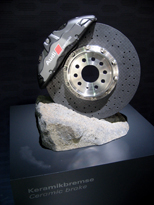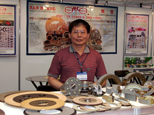Nan Hoang Traffic Instrument in Taiwan Aims For Top of Braking Segment
2009/04/07 | By Quincy Liang | NAN HOANG TRAFFIC INSTRUMENT CO., LTD.Fred Cheng, president of the Nan Hoang Traffic Instrument Co., Taiwan's largest manufacturer of friction material, recently confirmed that his company is working with strategic partners to develop the most advanced non-organic ceramic-fiber material and related equipment for making top-end ceramic brake discs and pads. These parts are currently used only on a very few car models, such as Audi's flagship A8 limousine and R8 super sports car.

Chen made the statement at the 2008 Intermot international motorcycle and scooter show in Koln, Germany. He said that the Chung-Shan Institute of Science and Technology (CSIST) initiated a project to develop such advanced material and products in 2007, after laboratory experiments had revealed some interesting possibilities that won the support of the Ministry of Economic Affairs (MOEA).
"Nan Hoang is the only company in Taiwan with enough R&D capability to exploit this new material, and we are the core of a strategic alliance that was established recently," Cheng comments. "We aim to complete the whole project, including the development of material and machinery, in the next two to three years; but there are still many challenges ahead, because this new material and its products are totally different in concept from conventional brake parts."

Advantages
The ceramic brake has several outstanding advantages, Cheng points out, including a service life about four times that of conventional steel brake discs: it can last up to 300,000 kilometers under normal day-to-day operating conditions. (Meaning that it will likely last longer than the vehicle it came with.). In addition, it offers outstanding braking power, even when the car is being driven to its limit, as well as supreme resistance to fading. Its unmatched light weight can also offer other benefits, such as driving comfort and easier handling.
Ceramic brake discs are made of reinforced ceramic, a material which has already proven its worth many times in the field of aeronautical and aerospace engineering. The most obvious advantage is unmatched corrosion resistance, and it is not susceptible to rust. Some of the technical benefits are even greater. A ceramic brake disc, for instance, can save some five kilograms of weight in each wheel of a vehicle.
Cheng says that his company has poured over NT$100 million (US$30.3 million at US$1: NT$33) into the purchases of a comprehensive range of testing, analysis, and inspection equipment. And, he claims, Nan Hoang currently operates one of the world's six (and Asia's two, the other one being in Japan) most advanced friction-material laboratories.
"The development of the ceramic brake is a big challenge," Cheng admits, "but also a great opportunity to once again prove Nan Hoang's strength."
Alliance
With an eye on the high potential of ceramic brakes and their role in the further upgrading of Taiwan's global competitiveness in the auto-parts business, the Department of Industrial Technology (DoIT) of the Ministry of Economic Affairs, CSIST, three private companies, and the Department of Materials Science and Engineering (DMSE) of I-Shou University signed an agreement in mid-2008 to form an alliance for the development of weight-saving brake modules.
The three private companies in the alliance, which will work to upgrade vehicular brake quality, performance, and safety, are V-Utmost Co., a vacuum melting expert, and Angen Machine Mfg. Co., a special-purpose machinery developer and manufacturer, in addition to Nan Hoang.
A senior CSIST official points out that the alliance will focus on establishing and integrating technology for the development of ceramic-base brake modules for automotive and motorcycle applications. This technology is expected to shorten production processes, cut costs, improve the production environment, and upgrade the value-added of Taiwan-made products.

